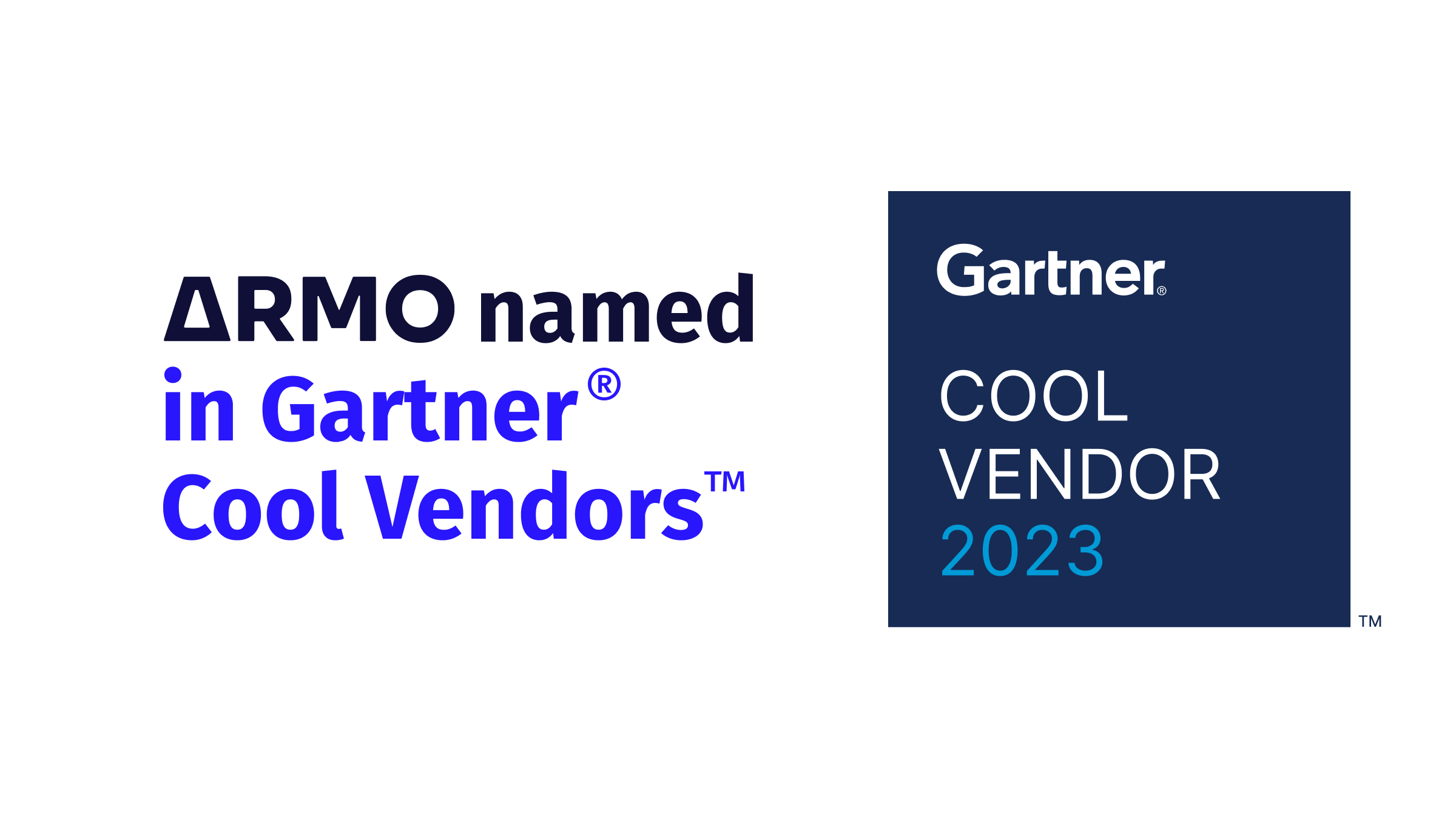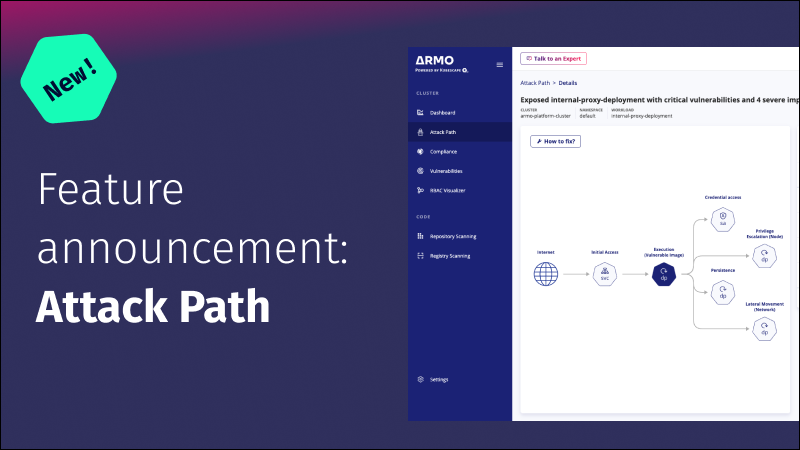ARMO named in Gartner® Cool Vendors™ report
We are excited and honored to announce that we were selected as Gartner Cool Vendor...

Apr 10, 2025
Software supply chain attacks cost businesses $45.8 billion globally in 2023 alone, and is projected to exceed $80.6 billion by 2026. According to Gartner’s projection, 45% of organizations will experience software supply chain attacks this year. These emphasize the importance of software supply chain security and the need for every organisation to prioritize it.
Software supply chain refers to the entire process and ecosystem involved in the development, integration, and deployment of software products. It includes every tool and system used to build and deliver the software, as well as the people involved. These components comprise both proprietary and third-party elements and they include the following:
| Source Code | The original code written by developers to create software applications. |
| Third-Party Libraries | These are pre-written code provided by external vendors or developers that offer specific functionalities. |
| Open-Source Components | Publicly available software components that are freely used and modified. |
| Version Control Systems | Tools such as Git that track and manage changes to source code over time. It helps developers maintain an audit trail of code changes, and facilitates accountability and rollback in case of issues. |
| Build Systems | These are automated tools that compile source code into executable software. |
| CI/CD Pipelines | Continuous Integration and Continuous Deployment pipelines automate the testing and deployment of code changes. It facilitates rapid delivery of software updates while ensuring code quality. |
| Software Distribution Channels | The pathways through which software is delivered to the end users, including app stores, repositories, etc. |
Software supply chain security is the practice of safeguarding all the aspects of software development and deployment process against threats and vulnerabilities. Each component of the SSC is vulnerable to specific security threats. As such, the integrity, confidentiality, and availability of every component needs to be ensured. The goal is to combine necessary cybersecurity and risk management strategies to prevent unauthorized access, tampering, and the insertion of malicious code in the software applications.
SSC is fraught with complexities that pose security challenges and make it susceptible to vulnerabilities. These challenges necessitate careful management and proactive strategies, and they are as follows:
The software development process involves countless components, including tools, libraries, and services that are interdependent. These components often come from different sources, creating a complex web of interconnections. This network of dependencies increases the attack surface and makes it challenging to identify and secure all entry points. An issue in one component can escalate through the system, and affect many parts of the software ecosystem.
Organizations rely heavily on third-party tools and libraries, often incorporating them without thorough due diligence. If those components contain flaws or malicious code, it introduces significant vulnerabilities into the supply chain. Meanwhile, keeping an inventory of all third-party components, understanding their origins, and ensuring their security is an equally challenging task. Even when updates and patches are applied promptly, maintaining visibility and control over external elements can be difficult.
Internal actors, including employees and contractors, also pose significant risks to the supply chain, whether through malicious intent or inadvertent actions. Insiders have access to the software development process and sensitive areas of the infrastructure. This could lead to intentionally introducing vulnerabilities, exfiltration of sensitive data, or unintentional errors that compromise security.
Identification and remediation of vulnerabilities are crucial to maintaining a secure supply chain. However, the sheer volume of software components and the constant discovery of new vulnerabilities make this task daunting. Coordinating updates, testing patches, and deploying them without disrupting operations requires a fine balance between speed and caution. Delays in patching leave systems exposed to exploits.
In an SSC attack, the attacker targets the most vulnerable elements of the SSC to compromise the application. The attack often involves introducing malicious code into the software or exploiting existing vulnerabilities. The goal is to infiltrate the software at its source or distribution points so that all users who rely on the compromised software are affected. Most times, losing funds or sensitive data. It does not only affect new products, attackers also target software update mechanisms by substituting legitimate updates with malicious versions, which are then widely distributed through trusted channels.
Some real-life events of software supply chain attacks are the following:
In December 2024, the Kong Kubernetes Ingress Controller experienced a significant security breach when a malicious Docker image was uploaded to DockerHub. The incident began with the compromise of a DockerHub Personal Access Token (PAT) used by Kong project maintainers, allowing the attacker to upload a cryptojacking version of the Kong Ingress Controller image (version 3.4.0). On December 29th, users reported unusually high CPU usage, a common sign of cryptojacking. The maintainers quickly removed the malicious images and revoked the compromised PAT by January 2nd, 2025, also rotating the keys used for uploading images. The incident highlighted the impact of compromised credentials and the need for robust monitoring mechanisms to detect such threats promptly.
Attackers targeted the popular VoIP software maker 3CX by inserting malicious code into the company’s desktop application, which was then distributed to millions of users. This attack highlights that even widely trusted software providers are vulnerable to supply chain infiltration.
The MOVEit exploitation, which began in May 2023, was a significant supply chain attack that affected numerous organizations worldwide. The attack exploited a zero-day vulnerability (CVE-2023-34362) in Progress Software’s MOVEit Transfer, a widely used managed file transfer (MFT) solution.
In 2023, the Python Package Index (PyPI) faced significant security challenges, including the discovery of 116 malicious packages that received over 10,000 downloads. These packages deployed various malware, including custom backdoors and the W4SP Stealer. Threat actors used multiple techniques to integrate malicious code, such as manipulating test.py scripts and embedding obfuscated code in init.py files. The situation led to temporary suspensions of new user registrations and project creations on PyPI. Ongoing threats included typosquatting attacks and “genuine” packages with hidden malicious code. A notable year-long supply chain attack using AI chatbot tools as lures was uncovered in November 2023, affecting over 1,700 downloads across more than 30 countries.
Threat actors exploited a vulnerability in Codecov’s Docker image creation process, inserting a single malicious line of code into the 1,800+ line Bash Uploader script that enabled widespread credential and sensitive data exfiltration. With over 29,000 enterprise customers, including major companies like GoDaddy and Procter & Gamble, the potential impact was massive. The attack compromised credentials, tokens, and keys across CI environments, affecting Codecov’s Bash Uploader, GitHub actions uploader, CircleCI Orb, and Bitrise Step.
In this attack, malicious actors breached the SolarWinds network and inserted a backdoor, called SUNBURST, into the Orion IT software platform updates. This compromised update was then distributed to thousands of SolarWinds customers, including numerous U.S. government agencies and major corporations. Thus, providing the attackers with wide-ranging access to various networks.
To protect yourself from supply chain attacks, it’s important to follow several best practices that can improve your overall security and help prevent potential vulnerabilities. Below are a few key strategies:
Software Bill of Materials (SBOM) is a detailed inventory of all components, libraries, and dependencies used in a software product. SBOM has been strongly recommended by the National Security Agency (NSA) in its Cybersecurity Information Sheet (CSI). By implementing SBOMs, you will gain greater visibility into your software assets. It also facilitates better vulnerability management and improved compliance with industry regulations. Using SBOM will ultimately help you make wise decisions about software components to use or replace.
Regularly scanning for vulnerabilities in third-party libraries is essential for maintaining a secure software supply chain. It’s advised to utilize automated dependency scanning tools to identify known vulnerabilities across all packages. Also implement continuous monitoring processes that keep track of vulnerabilities as new threats are discovered and ensure timely updates and remediation efforts. Conduct routine audits of dependencies to assess risks and eliminate components that are outdated or unsupported.
Establish and enforce secure coding standards across development teams. This includes best practices like input validation, error handling, and secure authentication. Regular code reviews should be conducted to identify potential security flaws or vulnerabilities. Incorporating automated code analysis tools will enhance these reviews and help you adhere to security standards. For this, consider software composition analysis (SCA), static application security testing (SAST), and dynamic application security testing (DAST).
Digital signatures help verify the authenticity and integrity of software components. Signing code with digital certificates assures users that the code has not been tampered with since it was created. This practice reduces the risk of supply chain attacks by enabling users to easily identify authentic software. It also builds trust with customers and partners, as they can verify the source of the software they are using.
Protecting build environments helps prevent unauthorized code changes during the build process. Use access controls, network segmentation, and continuous monitoring to minimize risks. Ensure security through incorporation of security testing tools that run automatically within CI/CD pipelines for early detection of vulnerabilities in the development process. Requiring multiple approvals for changes deployed through the pipeline to ensure that changes are thoroughly vetted.
Enforcing the use of lockfiles and version pinning ensures that software dependencies are explicitly defined and do not automatically update to newer versions without verification. This practice prevents unexpected changes that could introduce vulnerabilities. By controlling the exact versions of dependencies used, your applications run with only known, secure component versions.
Comprehensive access controls help you protect sensitive areas of your SSC. This involves defining who can access which resources and ensuring that only authorized personnel have access. Adhering to the principle of least privilege (PoLP) specifies that users only have the minimum access necessary to perform their roles. This limits the damage that can be caused by insider threats or compromised accounts. Also, implementing multi-factor authentication (MFA) further secures access.
Network segmentation involves isolating development, build, and deployment environments to limit exposure. By keeping different stages of the SSC in separate networks, you reduce the risk of lateral movement by malicious actors. If one segment becomes compromised, network segmentation helps contain the breach and prevent attackers from easily accessing other critical areas of your organization’s infrastructure.
Utilizing automation tools streamlines security processes, such as dependency scanning, vulnerability assessments, and code reviews. Automated systems quickly identify and remediate vulnerabilities, thereby reducing human error and response time.
Having a well-defined incident response plan helps in addressing security incidents effectively. This plan should outline preparation, detection, analysis, containment, eradication, recovery, and post-incident review. Assemble a dedicated incident response team equipped with the necessary training and resources to execute the response plan when a threat is detected. Regularly conduct drills and update the plan to reflect new threats and lessons learned from past incidents.
Software supply chains continue to grow in complexity. Attack against it has also increased, thereby making SSC security a vital practice for developers and organizations. Since modern software applications are rarely developed from scratch, they rely on open-source libraries and third-party resources. As a result the attack surfaces grow and the supply chain is exposed to critical vulnerabilities that can be exploited by malicious actors.
Implementing security best practices is important in safeguarding your software development lifecycle. The National Security Agency recommends the implementation of SBOM, and advises that SBOM management be approached in three steps: 1) examination and management of risk before acquiring software; 2) analyzing vulnerabilities after deploying new software; and 3) implementing incident management to detect and respond to new software vulnerabilities in runtime.
Adopting this alongside other security measures discussed above will enhance your software’s security posture. Imagine your software getting intercepted at the distribution or delivery stage. This is where digital signatures come in, as they indicate to users whether the software has been tampered with since deployment. The combined implementation of these best practices ensures the integrity of your software products and helps you gain the trust of customers and other stakeholders.
The software supply chain refers to the entire ecosystem involved in the development, integration, and deployment of software applications. This includes all components such as tools, libraries, and services, from source code development to the use of third-party libraries, and from build systems to the distribution of the final product.
SSC security is critical because vulnerabilities in any component of the supply chain can lead to security breaches and expose organizations to data theft, financial loss, and reputational damage. Growing reliance on third-party components and open-source software necessitates adopting security measures for the ecosystem.
The primary threat to the SSC is the infiltration of systems by malicious actors which often involves inserting malware into the software updates or exploiting vulnerabilities in third-party libraries, ultimately compromising the security of end-users.
Supply chain security risks can be reduced through various strategies, including implementing Software Bills of Materials (SBOM), conducting regular dependency scanning for vulnerabilities, enforcing secure coding practices, conducting thorough code reviews, utilizing digital signatures, securing build environments and CI/CD pipelines, establishing robust access controls and adhering to the principle of least privilege (PoLP).
Supply chain security software are specialized tools and platforms designed to monitor, manage, and enhance the security of software supply chains. These include dependency scanning tools, SBOM management tools, code review and static analysis tools, CI/CD security tools, and incident response platforms.
Originally published: Nov 15, 2023. Updated: April 10, 2025

We are excited and honored to announce that we were selected as Gartner Cool Vendor...

We are thrilled to announce that ARMO, the makers of Kubescape and ARMO Platform, has...

Discover the importance of mapping attack paths in Kubernetes and learn how to effectively enhance...